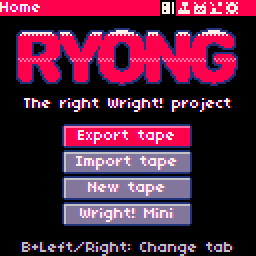Ryong
Tool, © KesieV 2017

KC Munchkin (1981) was one of the many Pac-Man clones that were on the market in the 80s. But, differently of the others - an the other games in general - it had a built-in level editor: choosing the 'EDITOR' option from the 'SELECT' screen, the game allowed you to create and play your own mazes.
The barrier between game creators and players has always been very thin: all in all videogames have been created by developers who wanted to play with computers and these humble and 'homebrew' origins have been in videogames DNA for decades.
Few years after Munchkin, Pinball Construction Set (1983) for Apple II appeared on the market. It wasn't just a videogame: it was a true visual videogame development tool that allowed players to build and play their own pinball tables. While it could look a pretty boring idea, it was a pure stroke of genius: the simplicity of pinball mechanics and the GUI revolution that exploded in that years provided the opportunity to enable non-coder players to actually make their own games.
But probably the earliest true videogame maker was Garry Kitchen's GameMaker (1985). It was an all-in-one tool that finally allowed the player to live the full production chain of a videogame: using the joystick it was possible to make custom graphics and sounds, tie everything together in a scene, define a simplified gameplay logic and finally play the full game.
In a review of Compute! Gazette the reviewer Niel Randall writes 'Like any good game, writing it is not easy, but once you've done so, the rewards are endless.'.
This mantra wouldn't have changed in the following years - even today: videogames and its development tools are getting more and more complex, its development cycle can last for years and involve dozens of people and cost a lot of money. So how the players can still live that endless rewarding feeling of making a game?
Players of the future still want to make games with easy tools like in the past. The long lasting bond between makers and players can't be broken. And the answer to this dilemma lies on the border between past and future, just where Pinball Construction Set was in the 80s.
The fantasy console phenomena exploded. Fantasy consoles are fascinating technical nonsenses: they are virtual machines you can use for making a game with simplified development tools and self-imposed technical limits, ranging from code size to chiptune sounds and limited color palette. I mean, it's weird, right?
But, as Apple well knows, limits can be enabling... and players are so desperately creative to accept to be stuck in the 80s, fueling the nostalgia, pixel art and chiptune movement for the future generations.
Plot!
Did you know that Wright! should have been a parametric game engine with very few genres hardcoded? Welp. I lost control very soon and now... I introduce you the true Wright! project, Ryong, made using the Wright! game engine. Now with 19 games and a Pico-8 palette as tribute!
Hold down the B BUTTON and hit LEFT/RIGHT for switching section: you can load/save/share your games or play some samples I made, play your own game, change the title screen, edit the stage screen and change the objects logic.
In the Title editor and the Level editor use the UP/DOWN/LEFT/RIGHT buttons for moving the cursor around, hit the B BUTTON for opening the tile selection screen and the A BUTTON for selecting and placing a tile.
In the Logic Screen use UP/DOWN/LEFT/RIGHT buttons for moving the cursor around and the A BUTTON for selecting it. Use the UP/DOWN buttons for moving around the properties list and the A BUTTON for selecting and changing properties values. Use the B BUTTON for going back to the previous properties group.
Your game is locally saved automatically every time you change something - you'll see a tiny floppy disk on the upper right corner of the screen when the time is right.
Okay... this time everything it's quite harder to explain and probably I should write a tiny manual. For now, just move and click around... if you're stuck, drop me a line on Twitter.
(Want to share something? You can find me on Twitter!)
 Install / Add to home
Install / Add to home
 View game sources
...or play it online below!
View game sources
...or play it online below!